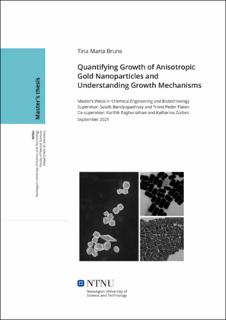| dc.contributor.advisor | Flaten, Trond Peder | |
| dc.contributor.advisor | Bandyopadhyay, Sulalit | |
| dc.contributor.advisor | Zürbes, Katharina | |
| dc.contributor.advisor | Raghunathan, Karthik | |
| dc.contributor.author | Bruns, Tina Maria | |
| dc.date.accessioned | 2021-12-16T18:22:10Z | |
| dc.date.available | 2021-12-16T18:22:10Z | |
| dc.date.issued | 2021 | |
| dc.identifier | no.ntnu:inspera:77798797:14874966 | |
| dc.identifier.uri | https://hdl.handle.net/11250/2834799 | |
| dc.description.abstract | Studiet av anisotrope gullnanopartikler (AuNPs) og deres vekst er et område av stor interesse på grunn av deres bemerkelsesverdige biokompatible og plasmoniske egenskaper. Disse egenskapene er sterkt avhengig av størrelse og form, noe som gjør det nødvendig å forstå veksten og justere metoden for å få kontroll over formene og egenskapene til AuNPs.
Dette arbeidet fokuserer på «seed-mediated», sølvassistert vekst av AuNPs og utvidelse av kunnskapen innhentet av Raghunathan et al. og i prosjektoppgaven min. En eksperimentell tilnærming for å forstå veksten ble brukt, og effekten av reduserende middel, oljesyre (OA), pH og ioner var i hovedfokus.
Effekten av varierende mengder OA ble utforsket med et alternativt reduksjonsmiddel, Tannic Acid (TA), i en «screeningsdesign» bestående av 13 eksperimenter. pH og mengde sølvnitrat ble også variert. Matematiske modeller ble laget basert på de resulterende lengdene og sideforholdene til partiklene, og det ble funnet at syntesene sjelden ga AuNPs ved pH 1,5.
En høyere pH-verdi (11) og en høyere mengde OA (200 uL) ble studert. For å utforske virkningene av pH nærmere, ble effekten av ionene som ble tilsatt for å endre pH undersøkt ved å tilsette den samme mengden ioner på forskjellige tidspunkt i syntesen. Dette ble gjort med 0, 20 og 200 uL OA. Det ble sett at mengden OA hadde en dominerende effekt på systemet, mens tiden for tilsetning av ioner hadde liten eller ingen effekt på sluttproduktet. Karakterisering av AuNPs ble hovedsakelig gjort ved bruk av UV-Vis og S(T)EM.
Utbytte ble studert ved hjelp av MP-AES for noen av syntesevariantene. Utbyttet ble funnet å være 12.2, 25.3 og 94.9 % for henholdsvis syntese uten sølv, med sølv og med sølv og 20 uL OA. Dette pekte mot den doble rollen til OA som «co-surfactant» og reduserende middel.
Til slutt ble arbeidet avrundet med en diskusjon rundt mulige vekstmekanismer. | |
| dc.description.abstract | The study of anisotropic gold nanoparticles (AuNPs) and their growth is an area of great interest due to their remarkable biocompatible and plasmonic properties. These properties are highly size- and shape-dependent, making it necessary to understand the growth and to tune the method to gain control over the shapes and properties of the AuNPs.
This work focuses on the seed-mediated, silver-assisted growth and expanding the knowledge obtained by Raghunathan et al. and the knowledge gained in my project leading up to this work. An experimental approach to understand the growth was used, exploring the effects of the reducing agent, Oleic Acid (OA), pH and ions as the main topics.
The effects of varying amounts of OA were explored with an alternative reducing agent, Tannic Acid (TA), in a screening design consisting of 13 experiments. The pH and amount of AgNO_3 were also varied. Mathematical models were made based on the fit from the resulting lengths and aspect ratios, and it was found that the syntheses rarely yielded AuNPs at pH 1.5.
A higher pH (11) and a higher amount of OA (200 uL) were studied. Further, to decouple the effects of pH, the effect of the ions added to change the pH were investigated by adding the same amount of ions at different times in the synthesis. This was done with 0, 20 and 200 uL OA. It was seen that the amount of OA had a dominating effect on the system, while the time of adding ions had little to no effect on the final product. Characterization of the final AuNPs was mainly done by UV-Vis and S(T)EM.
A yield study was conducted using microwave plasma atomic emission spectrometry for some of the syntheses variations. The yield was found to be 12.2, 25.3 and 94.9 % for syntheses without silver, with silver and with silver and 20 uL OA, respectively. This pointed towards the dual role of OA as co-surfactant and reducing agent.
Finally, the work was rounded off by a discussion around possible growth mechanisms. | |
| dc.language | eng | |
| dc.publisher | NTNU | |
| dc.title | Quantifying Growth of Anisotropic Gold Nanoparticles and Understanding Growth Mechanisms | |
| dc.type | Master thesis | |
